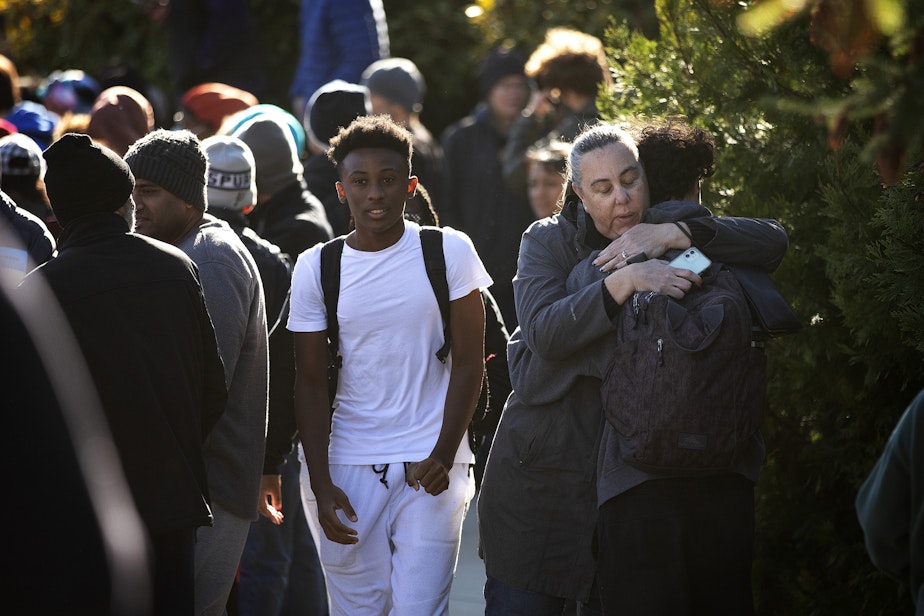What do students need to help them process the Ingraham High shooting?

In 2014, Susana Barbosa was a freshman at Marysville-Pilchuck High School when a student fatally shot four classmates and himself in the school cafeteria.
“I was sitting about 15 feet away, so I saw everything that happened,” Barbosa said.
Barbosa was next to a friend who pushed her to the ground. Together they crawled out of the building and climbed over a fence to escape.
“It didn’t hit me necessarily like the first or the second night, but definitely the third night, that’s when I had trouble sleeping and that’s when I just kind of took out all my anxiety on just eating and eating,” Barbosa remembers.
Last week’s shooting at Ingraham High School has prompted cries for more ongoing mental health counseling. Barbosa, who survived the school shooting in Marysville eight years ago, said it took a lot for her to heal: more than a year of therapy, both on her own and in a group.
Barbosa said she started having nightmares a few days after the shooting, replaying what she experienced and imagining different endings. Those dreams kept her up at night for months.
“I was just terrified that that nightmare — it would come to life,” she said.
Sponsored
Her dad found her a therapist, who diagnosed her with PTSD and prescribed anxiety medication. And the school organized weekly group therapy for all the students.
“Knowing that it’s not just you” was really helpful, Barbosa said. “It was just really nice to talk to someone going through something similar that you were going through.”
The students shared tips about how to cope — “basically just kind of helping each other,” Barbosa said.
The Seattle School District organized drop-in counseling at a nearby community center for two days after the Ingraham shooting, and drop-in Zoom counseling over the weekend.
Superintendent Brent Jones said in a school board meeting that counselors and social workers were on site when students came back to school Monday.
Sponsored
“We’ll be working diligently to get our support in place that are both short and long-term mitigation efforts,” he said. “I’m asking you all to join me and us in our efforts to make our schools safe, welcoming places of belonging.”
Students and families also see a need for a lot more ongoing support.
On Monday, thousands of students across Seattle walked out of school and met in front of City Hall to demand, among other things, more funding for students’ mental health needs.
Matilda Barber, a junior at Ballard High School, said they’re still feeling the effects of last week’s shooting.
“I was really shaken up, and it just threw off the rest of the week too,” they said. “Even after they announced we were safe and everything, I could not do my schoolwork properly.”
Sponsored
There’s currently one counselor for every 350 students in Seattle’s public high schools. The students are demanding the district nearly double that number, so there are more counselors on hand to help students dealing with stress, trauma or other issues.
Parents also want more from the district.
Deanna Meyerhoff, the mother of sophomore twins at Ingraham, said she’d like the school to organize time to discuss and process the events in small groups, like advisories, classes or group therapy sessions.
“There's tons of other kids like my kids who won't go unless they're told that they have to,” Meyerhoff said. “And I think it would be very helpful for them to be in a group with other people who've had a similar experience.”
Other parents also said their teens don’t necessarily know what they need and so should have a number of options available to them on an ongoing basis.
Sponsored
Annika Carlsten, the mother of a senior and a freshman at Ingraham, said she's heard people saying that this wasn’t a school shooting — it was a shooting at a school. That worries her, because she wants the students’ trauma to be taken seriously.
"My kid sent me a text that said, ‘I'm okay for now.’ And like, what does that mean? Sorry. That's the part where it's like, they know how this plays out," she said, fighting back tears.
Carlsten said her sons would be unlikely to open up in group therapy or classroom discussions. What she wants for them is a way for kids to share their stories anonymously, inside the Ingraham community.
“A space in which they can get out of their head everything that they are remembering in a way in which they can be vulnerable,” she said. “They can say, you know, ‘This really scary thing happened to me,’ and have it validated.”
Carlsten also wants the school to come up with a plan for how to do — or not do — lockdown drills, so students don’t have to relive their trauma.
Sponsored
Back in Marysville, Susana Barbosa said it took her more than a year to stop having nightmares and eating compulsively — to stop going off by herself and running on autopilot when she did activities she used to love.
“I started noticing that I enjoyed going to practice, going to do this [or that], and having fun,” she said. “I started to realize that I’m getting better.”
Barbosa is now studying marketing and communications at the University of Washington, and she has a full-time job. She plans to graduate in the spring.
More information about how to talk to kids about school shooting is available here:
https://www.kuow.org/stories/processing-what-happened-in-uvalde




